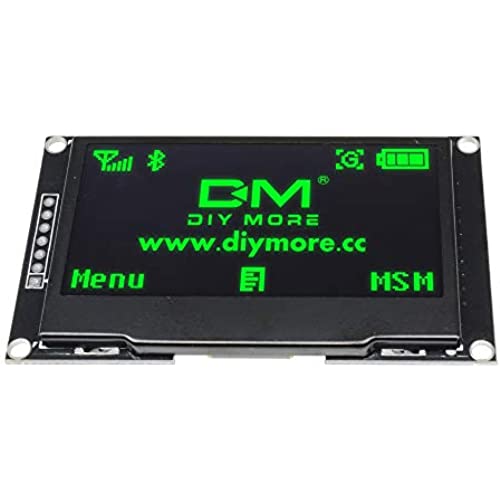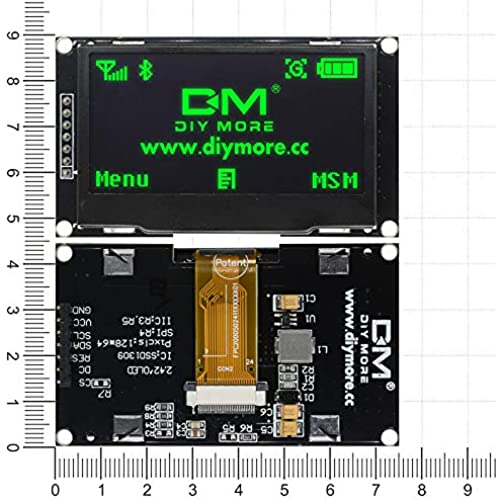



















diymore 2.42 OLED Digital IIC I2C SPI Serial 128X64 Pixel LCD Screen Display Module SSD1309 for DIY Electronic (Green)
-

Glenn Biggers
> 24 hourI followed the instructions for converting to I2C but could not get it to display anything on my Raspberry Pi Pico until I hooked the RES to a GPIO pin set for OUT and PULL_UP and pulsed it low in my program. Works OK now.
-

Walt Handerberg
> 24 hourIf you are using this for I2C beware. You may need to force it into i2c (not SPI) mode. I never got mine to work for more than a few mins and thew it in the garbage. I got another one without SPI support that worked the first time.
-

J. Shanahan
> 24 hourThese suffer from OLED burn in if used too long. Here is my display after about 6 months of displaying numbers. Note the small numbers burned in.
-

Ryan M
> 24 hourThis module was purchased as a gift for my brother. We are both studying for Engineering and love tinkering around with electronics. This module is on the pricy side and is rather small, but it a vibrant and easy to use display. The module supports both I2C and SPI depending on how you have the pins setup. There are also driver that you can find on the internet to help support the use of this screen or you can write the drivers yourself which is more fun by using the datasheet of the module to write data and read data to SPI/I2C memory-mapped registers. Seeing how much excitement he got out of it makes me want to buy another one for myself. Fast shipping too, awesome O-LED company
-

zypher
> 24 hourLove the extra screen real estate. Im building a cyberdeck/smart watch project with this screen and it is a fantastic fit for the purchase. Highly recommend Green.
-

CoreyCoop
> 24 hourIf you have a lot of pixels on on a line lit, it is noticeably dimmer than when there are just a few pixels. For instance, the descenders of y and g are significantly brighter than the body of line of text. Not a deal breaker for me, since I havent found this size of OLED display anywhere else.
-

Jason S
> 24 hourWorking on some projects with a Raspberry Pi Pico using a ported SSD1306 library. My project required I2C communication and I had some difficulty at first. I validated the OLED worked via SPI, so after a bit of fiddling I figured out the combination: 1. Move R4 resistor to R3 2. Bridge the R5 pads (0 ohm resistor, solder bridge or wire will work) 3. Connect the RES pin to source voltage (connected to RUN pin on Pi Pico) 4. Connect the GND, VCC, SDA, SCL lines normally Step 3 wasnt documented anywhere I could find. Figured it out after some Googling and trial and error. After all was said and done, I was able to run this OLED at 3.3v and 5v via SPI and I2C. I tested I2C up to 800 kHz (didnt try higher) and it worked great. I dont know if running it out of spec will kill it faster, but I was impressed with the variety of options that worked. The display refreshes just a tad slower than the smaller OLED displays I have, but thats not a knock against it. I have the green and blue versions and both look amazing and perform great for my use case. As someone else said, the pins are labeled in a weird way, but its easy enough to figure out what goes where. Would definitely get more if needed.
-

Micah Blomgren
> 24 hourUsing with SPI, works great once I figured out how my mcu board talks to SPI. I love that it is green. Wonderful
-

William Kautter
> 24 hourI bought mine directly from DIYMORE. It was tested in a system already functioning with a I2C 128x64 OLED display. The specified modifications were made to the board. There was no response on the display and an I2C scanner did not see the device. So basically non functioning and the company is not responding to requests for replacement.
-

Gabjoo Lim
> 24 hourGreat oled display for Small gadget. One of the best oled you can find with 128x64 resolution. It works with luma.oled python library without hassle. Be aware of 3.3V vdd. This module does not have voltage regulator.
